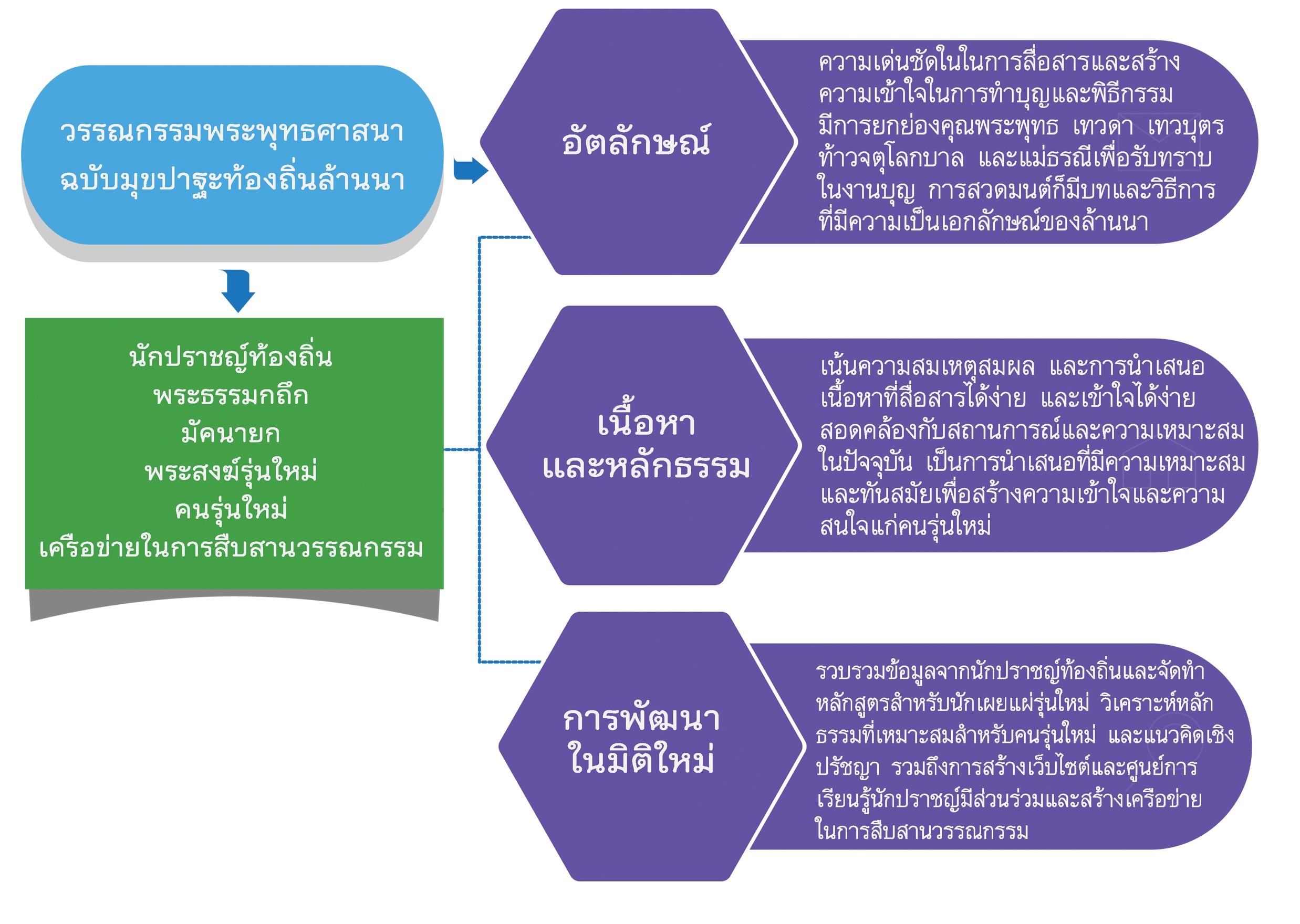Buddhist Literature in Lanna as Local Oral Traditions; Identity, Development and Value-Adding in New Dimension
Main Article Content
Abstract
The purposes of this research were 1) analyze the identity and development of Lanna oral traditions of Buddhist literature; 2) analyze the content, principles, and propagation of Buddhism for the new generation, 3) propose an approach for increasing the value and managing Lanna local oral Buddhist literature in a new dimension. It was Mixed-Method Research. The samples consisted of: 1. the sample group who answered the questionnaire was 152 monks and 152 deacons, 2. the interviewee group was 2 monks 2 deacons and 2 academics. Tools used for data collection: 1. Questionnaire, percentage, mean and standard deviation statistics were used to analyze the data, 2. Structured interview form. Data were analyzed using descriptive analysis.
The research result finds that:
1. The identity of the Lanna oral language edition of Buddhist literature focuses on the dharma and Buddhist philosophy and has specific features that reflect the beliefs and ways of life of the communities in the North and are adapted according to the local context and community current events.
2. Contents and principles in propagating Buddhism for the new generation should focus on self-dominance, people-dominance, and work-dominance based on the basic principles such as Benjasila, Benjadham, Brahmawiharn, Idthibat, and worldly dharmas.
3. Enhancing the value and management of Lanna local oral Buddhist literature in this new dimension by disseminating religious knowledge and experience to stimulate mental development and good way of life by enhancing understanding and happiness in the lives of the new generation in Thai society and around the world.
Article Details

This work is licensed under a Creative Commons Attribution-NonCommercial-NoDerivatives 4.0 International License.
เพื่อให้เป็นไปตามกฎหมายลิขสิทธิ์ ผู้นิพนธ์ทุกท่านต้องลงลายมือชื่อในแบบฟอร์มใบมอบลิขสิทธิ์บทความ ให้แก่วารสารฯ พร้อมกับบทความต้นฉบับที่ได้แก้ไขครั้งสุดท้าย นอกจากนี้ ผู้นิพนธ์ทุกท่านต้องยืนยันว่าบทความ ต้นฉบับที่ส่งมาตีพิมพ์นั้น ได้ส่งมาตีพิมพ์เฉพาะในวารสาร วิชาการธรรม ทรรศน์ เพียงแห่งเดียวเท่านั้น หากมีการใช้ ภาพหรือตารางของผู้นิพนธ์อื่นที่ปรากฏในสิ่งตีพิมพ์อื่นมาแล้ว ผู้นิพนธ์ต้องขออนุญาตเจ้าของลิขสิทธิ์ก่อน พร้อมทั้ง แสดงหนังสือที่ได้รับการยินยอมต่อบรรณาธิการ ก่อนที่บทความจะได้รับการตีพิมพ์References
บัวผิน ฝาแก้ว, ศักดิ์พงศ์ หอมหวล และสมบัติ ฤทธิเดช. (2554). การเรียนรู้วรรณกรรมท้องถิ่นโดยกระบวนการจัดการความรู้. วารสารมหาวิทยาลัยราชภัฏมหาสารคาม, 5(1), 121-129.
บุญศิริ สุขพร้อมสรรพ์ และศรีสุดา วงษ์ชุ่ม. (2561). การอนุรักษ์และพัฒนาชุมชนเมืองเก่าพะเยา. วารสารมหาวิทยาลัยศิลปากร, 38(3), 105-126.
พระปลัดจตุพร วชิรญาโณ. (2562). โคม: แนวคิดประวัติศาสตร์และกระบวนการสร้างอัตลักษณ์วัฒนธรรมพระพุทธศาสนาแบบล้านนา. วารสารสันติศึกษาปริทรรศน์ มจร, 7(1), 34-45.
พระปลัดบุญช่วย ฐิตจิตฺโต, พระครูปลัดกิตติพงษ์ กิตฺติโสภโณ และพระนภดล ปภสฺสรวํโส. (2566). การสร้างอัตลักษณ์ของชุมชนชาวพุทธล้านนา. วารสารสังคมศึกษา ศาสนาและวัฒนธรรม, 4(1), 83-84.
มหาจุฬาลงกรณราชวิทยาลัย. (2539). พระไตรปิฎกภาษาไทย: ฉบับมหาจุฬาลงกรณราชวิทยาลัย. กรุงเทพฯ: มหาจุฬาลงกรณราชวิทยาลัย.
ลภัสรินทร์ ฉัตรวังคีรี. (2561). ชุมชนทางชาติพันธุ์และศูนย์กลางแลกเปลี่ยนสินค้ากับการประกอบสร้างอัตลักษณ์ล้านนาในวรรณกรรมของมาลา คําจันทร์ และพิบูลศักดิ์ ละครพล. วารสารมนุษยศาสตร์และสังคมศาสตร์ มหาวิทยาลัยราชภัฏสุราษฎร์ธานี, 10(2), 37-66.
วัชรินทร์ แก่นจันทร์. (2556). อุดมการณ์ความเป็นอื่นในวรรณกรรมล้านนา. วารสารมนุษยศาสตร์และสังคมศาสตร์, 1(2), 261-269.

